Hong Kong hosted the inaugural Belt and Road Summit to explore business opportunities arising from China’s far-reaching development strategy.
From top government officials to investors, project owners and services professionals, more than 2,400 participants attended the most authoritative conference to date on China’s Belt and Road Initiative, which covers more than 60 countries spanning Asia, Europe, the Middle East and Africa. The inaugural Belt and Road Summit, held 18 May at the Hong Kong Convention and Exhibition Centre, featured more than 20 senior government ministers from countries along the Belt and Road, as well as business leaders from Hong Kong, the Chinese mainland, ASEAN and other regions, to discuss how to turn the strategy into reality.
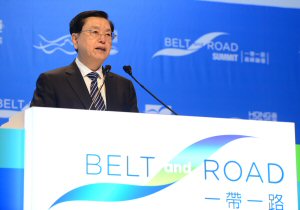
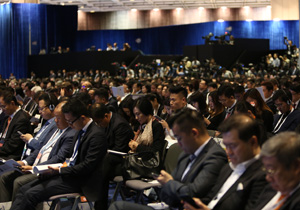
In his keynote speech, Zhang Dejiang, Member of the Standing Committee of the Political Bureau of the Communist Party of China Central Committee, and Chairman of the Standing Committee of the National People’s Congress of the People’s Republic of China, said that the Initiative promotes common development and brings benefits to economies along the route.
“The Belt and Road Initiative answers the call of our times for a joint response to risk and joint efforts to strengthen global economic recovery,” said Mr Zhang. As a pivotal player in the development strategy, Hong Kong, he said, can play a leading role in four areas: building a platform of comprehensive services; facilitating capital flows and promoting renminbi internationalisation; promoting cultural exchanges, and deepening cooperation with the mainland to jointly develop markets along the Belt and Road.
Policymaker Perspective
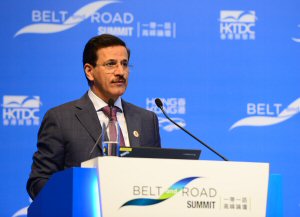
Organised by the Hong Kong Government, with support from the Central People’s Government and in association with the Hong Kong Trade Development Council (HKTDC), the one-day summit featured three panel sessions, including one that analysed opportunities from the policymakers’ perspective.
Existing regional hubs such as Hong Kong and the United Arab Emirates (UAE), which is a gateway to more than two billion consumers in the Middle East, stand to benefit from the Initiative. But according to Sultan Saeed AlMansoori, Minister of Economy of the UAE, governments have to lay the groundwork by coordinating policies and regulations.
“For the initiative to succeed, governments should be unified when it comes to the policies and strategies for regional cooperation for economic integration and for harmonising laws and regulations governing how business is done between the two sides. That will be a big challenge for us as nations,” he said.
New Asset Class
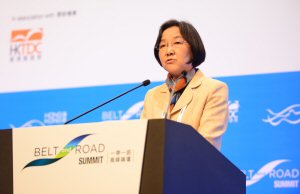
Enhancing cross-sector connectivity among economies along the Belt and Road was a topic tackled by a panel of leading international conglomerates. According to Douglas Flint, HSBC Group Chairman, the Initiative comes at an opportune time, when the world is awash with excess capacity and ample liquidity.
“Channelling China’s savings away from simple bank deposits and T-bill into infrastructure throughout the region is an enormous opportunity not only to enhance returns, but also to enhance the aggregate demand in the region,” said Mr Flint. “This is another opportunity to create a bond market in Asia through China and to provide an asset class the rest of the world can invest in.”
The panel also explored the role of the newly created Asian Infrastructure Investment Bank (AIIB). Dr DJ Pandian, AIIB Vice President and Chief Investment Officer, said the institution’s mandate is to promote regional cooperation and help developing member countries improve their infrastructure. He said the AIIB would work with other multilateral development banks to forge a common framework for financing Belt and Road projects.
Along with the AIIB, the US$40 billion Silk Road Fund was established to help finance Belt and Road projects, mainly in infrastructure and resources, as well as projects related to industrial and financial cooperation. Jin Qi, Chairman of the Silk Road Fund, said that Hong Kong can facilitate communications and connections among Belt and Road countries, and can provide an ideal platform for financing and asset management.
The Initiative, she said, will also further internationalise the renminbi, particularly since its inclusion last year in the International Monetary Fund’s Special Drawing Rights basket of currencies.
ASEAN Equation
The final panel examined the crucial role of ASEAN (Association of Southeast Asian Nations) in the Belt and Road Initiative, which complements the goals of the newly formed ASEAN Economic Community, according to panel speakers. The region, they said, would greatly benefit from infrastructure development that would help further integrate Southeast Asia, particularly in archipelagos such as Indonesia and the Philippines.
“Hong Kong can promote itself to other ASEAN countries as an important conduit to China. It is a cultural translator.”
Hong Kong, with its extensive experience operating in the region, can serve as a conduit to Chinese investment in the Southeast Asia, said Teresita Sy-Coson, Vice Chairperson of the Philippine SM Investments Corporation. “We can’t imagine a world without Hong Kong,” said Ms Sy-Coson. “This is an area that has a long experience with international business, so it’s a good conduit for China and other countries. Hong Kong can promote itself to other ASEAN countries as an important conduit to China. It is a cultural translator.”
The Road Ahead
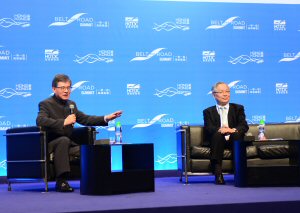
The role of Hong Kong and Shanghai as “strategic pivots” were examined in a dialogue with Wang Zhan, President of the Shanghai Academy of Social Sciences and Executive Vice President of the Yangtze Council.
Mr Wang noted that both cities, with their substantial resources and deep experience in helping to implement the Chinese mainland’s economic reforms over the last 30 years, have much to offer. He projected that about 10 to 20 nodal cities would be identified along the Belt and Road, that are geographically positioned to receive the first round of investments to develop industrial parks and special economic zones. With Hong Kong taking a lead role in raising capital, Shanghai, he said, can offer its expertise in setting up special economic zones.
Professional in the Spotlight
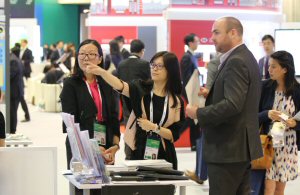
The Belt and Road Summit also included an exhibition, with 27 Hong Kong services providers showcasing their expertise in banking and financial services, infrastructural development and professional services. At the Global Investment Zone, 10 countries introduced their investment projects to international investors.
The HKTDC also organised a full-day trip to Shenzhen and Qianhai for delegates to learn about the latest plans and developments in these mainland Free Trade Zones. The Qianhai-Shekou Area in Shenzhen is slated to play a crucial role under the Belt and Road Initiative, providing a strategic platform for cooperation between Shenzhen and Hong Kong in a range of professional services.
HKTDC Chairman Vincent HS Lo said that the summit represented a milestone in HKTDC efforts to promote Hong Kong “as an integrator that brings together governments, capital and expertise to maximise Belt and Road opportunities.”
Mr Lo announced that the Belt and Road will become an annual event, with next year’s summit to be held 11 September 2017. He emphasised the need for governments and businesses to work together, with Hong Kong playing a strategic role as a connector. “While this conference is one small step, it will be a giant leap to turn this grand scheme into reality.”
Related Links

Comments